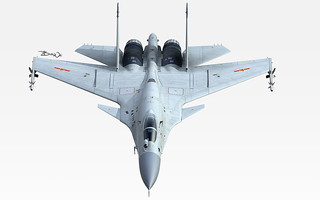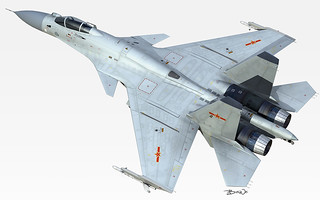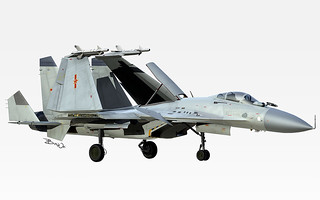Iran Captures US" Scan Eagle" Unmanned Aerial Vehicle
(UAV). Iranian state television has shown images of what it says is an unmanned
US drone captured in its airspace brought down a Scan Eagle.
Without an appropriate military power, a small state is on the mercy of neighboring big states; which senses its sovereignty is under threat..........
Monday, April 29, 2013
Talk of the Day -- Taiwan to develop own 3rd-generation warplane
Taiwan's
military is determined to develop third-generation warplanes under its own
steam, as the United States remains reluctant to approve its request to procure
66 F-16 C/D jet fighters, according to local media reports.
The decision is also prompted by China's incessant military buildup, including the introduction of new high-performance jet fighters and missiles, the reports said.
Citing a newly released quadrennial defense review, the reports said the Air Force will develop a new generation of warplanes with advanced features such as stealth, long-range flight and aerial refueling abilities, and the capability of launching missiles against land targets or ships.
The Ministry of National Defense (MND) said in the defense review that China's People's Liberation Army (PLA) has stepped up the replacement of weapons systems and military equipment in its Nanjing and Guangzhou military regions, both of which are adjacent to Taiwan, in recent years.
Moreover, the report said, most PLA training programs and live-fire exercises have focused on seeking a speedy end to island conflicts in an apparent effort to prevent foreign intervention in the event of such a standoff.
The following are excerpts from local media coverage of highlights of the MND's newly released quadrennial defense review:
The decision is also prompted by China's incessant military buildup, including the introduction of new high-performance jet fighters and missiles, the reports said.
Citing a newly released quadrennial defense review, the reports said the Air Force will develop a new generation of warplanes with advanced features such as stealth, long-range flight and aerial refueling abilities, and the capability of launching missiles against land targets or ships.
The Ministry of National Defense (MND) said in the defense review that China's People's Liberation Army (PLA) has stepped up the replacement of weapons systems and military equipment in its Nanjing and Guangzhou military regions, both of which are adjacent to Taiwan, in recent years.
Moreover, the report said, most PLA training programs and live-fire exercises have focused on seeking a speedy end to island conflicts in an apparent effort to prevent foreign intervention in the event of such a standoff.
The following are excerpts from local media coverage of highlights of the MND's newly released quadrennial defense review:
Liberty
Times:
Ruling Kuomintang Legislator Lin Yu-fang said recently that Taiwan's determination to build indigenous submarines and new- generation of warplanes is partly driven by Washington's increasing reluctance to assist Taiwan in defending its national security.
Although the two sides of the Taiwan Strait are seeking reconciliation, China's intention to annex Taiwan has remained unchanged as reflected in repeated exposure of China-related espionage cases, Lin said.
"For our national survival, we need to build up our defense capability under our own steam," Lin said, adding that building indigenous submarines and warplanes is part of the efforts.
According to the MND's quadrennial defense review, the military is also planning to develop unmanned aerial vehicle (UAV) capable of carrying out combat and reconnaissance missions to beef up the country's air defense muscle.
Nevertheless, MND spokesman Luo Shou-he said Tuesday that the decision to build indigenous warplanes does not mean that the military has ruled out the option of procuring F-16 C/Ds or even more advanced types of jet fighters.
"We have struck a deal with the United States on upgrading our F-16 A/B fighters and will continue evaluate our need for advanced warplanes," Luo added.
According to the MND's budget plan, there are still nearly NT$500 billion (US$16.89 billion) worth U.S. weapon procurement projects to be executed over the next five to 10 years.
Meanwhile, military sources said that indigenous submarine and warplane development projects will cost an estimated NT$500 billion. (March 13, 2013).
Ruling Kuomintang Legislator Lin Yu-fang said recently that Taiwan's determination to build indigenous submarines and new- generation of warplanes is partly driven by Washington's increasing reluctance to assist Taiwan in defending its national security.
Although the two sides of the Taiwan Strait are seeking reconciliation, China's intention to annex Taiwan has remained unchanged as reflected in repeated exposure of China-related espionage cases, Lin said.
"For our national survival, we need to build up our defense capability under our own steam," Lin said, adding that building indigenous submarines and warplanes is part of the efforts.
According to the MND's quadrennial defense review, the military is also planning to develop unmanned aerial vehicle (UAV) capable of carrying out combat and reconnaissance missions to beef up the country's air defense muscle.
Nevertheless, MND spokesman Luo Shou-he said Tuesday that the decision to build indigenous warplanes does not mean that the military has ruled out the option of procuring F-16 C/Ds or even more advanced types of jet fighters.
"We have struck a deal with the United States on upgrading our F-16 A/B fighters and will continue evaluate our need for advanced warplanes," Luo added.
According to the MND's budget plan, there are still nearly NT$500 billion (US$16.89 billion) worth U.S. weapon procurement projects to be executed over the next five to 10 years.
Meanwhile, military sources said that indigenous submarine and warplane development projects will cost an estimated NT$500 billion. (March 13, 2013).
United Daily
News:
The MND released the 2013 Quadrennial Defense Review (QDR) Monday.
It marked the second time that the ministry has issued such a reportsince
President Ma Ying-jeou took office in May 2008.
The latest version contains fewer pages than the first edition unveiled in
March 2009.
The most significant difference between the two editions lies in the
government's stance toward the establishment of cross-strait military
confidence building mechanism.
The 2009 QDR quoted Ma as having repeatedly urged China to dismantle its
missile deployment against Taiwan and as having proposed a three-stage plan to
establish a military confidence building mechanism.
In contrast, the 2013 edition said the conditions are not yet ripe for the establishment
of such a mechanism.
The latest version instead reaffirmed the government's "economy
first" principle in dealing with cross-strait relations.
Meanwhile, the 2013 review only briefly mentioned China's military buildup
efforts in three pages, while the 2009 edition clearly listed China's military
threats to Taiwan in eight pages.
The new version also stressed Taiwan's commitment to the international
regulations of non-proliferation of nuclear weapons, saying Taiwan would never
produce or use nuclear weapons.
The 2013 QDR also stressed that Taiwan has included provisions of the Missile
Technology Control Regime into Taiwan's trade law to prevent the proliferation
of missile and unmanned aerial vehicle technology. (March 12, 2013).
Sunday, April 28, 2013
CGI of Chinese J-15 Flying Shark Naval Fighter Jet

Chinese J-15 Flying Shark Naval Fighter Jet

The J-15 Flying Shark naval fighter jet flew for the first time August 31, 2009. The J-15 Flying Shark will carry weapons like PL-8/PL-10 Short Range Within Visual Range Air-to-Air Missile, PL-12 Beyond Visual Range Air to Air Missile (BVRAAM) and YJ-83K AShM

China's J-15 Flying Shark Naval Fighter Jet Superior To Su-33
Chinese media is claimg that Its carrier-borne J-15 flying shark naval fighter jet was independently developed and uses many brand-new systems including radar, avionics takeoff and arrester hook.
Chinese media has claimed the multirole capabilities of the J-15 fighter jet allows it to condduct antiship/antisurface and anti air warfare which make it far more superior even though its appearance is similar to Su-33.
The Spokesperson of the Chinese Ministry of National Defense, Geng Yansheng has said, "The world military affairs have an objective law of development. Many weapons have the same design principle and some command and protection methods are also similar. Therefore, it at least is non-professional to conclude that China copied the aircraft carrier technology of other countries only by simply comparison.”
He added that J-15 has far more advance avionics and its fire-control computer is also very advance. The J-15 is lighter in weight and have greater strength due to the new materials used and it is powered by Chinese Taihang (WS-10a) turbofan engine.
Subscribe to:
Posts (Atom)
le.jpg)

+HIT+Al+Khalid+(MBT+2000)+Type+90-IIM+Main+Battle+Tank+(1).jpg)
+HIT+Al+Khalid+(MBT+2000)+Type+90-IIM+Main+Battle+Tank+(2).jpg)
+HIT+Al+Khalid+(MBT+2000)+Type+90-IIM+Main+Battle+Tank+(3).jpg)
+HIT+Al+Khalid+(MBT+2000)+Type+90-IIM+Main+Battle+Tank+(4).jpg)
+HIT+Al+Khalid+(MBT+2000)+Type+90-IIM+Main+Battle+Tank+(5).jpg)
+HIT+Al+Khalid+(MBT+2000)+Type+90-IIM+Main+Battle+Tank+(6).jpg)
+HIT+Al+Khalid+(MBT+2000)+Type+90-IIM+Main+Battle+Tank+(7).jpg)








